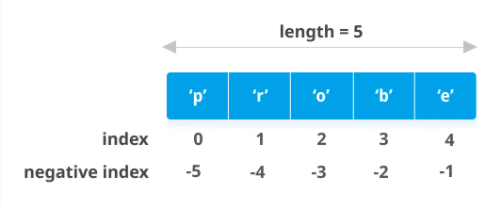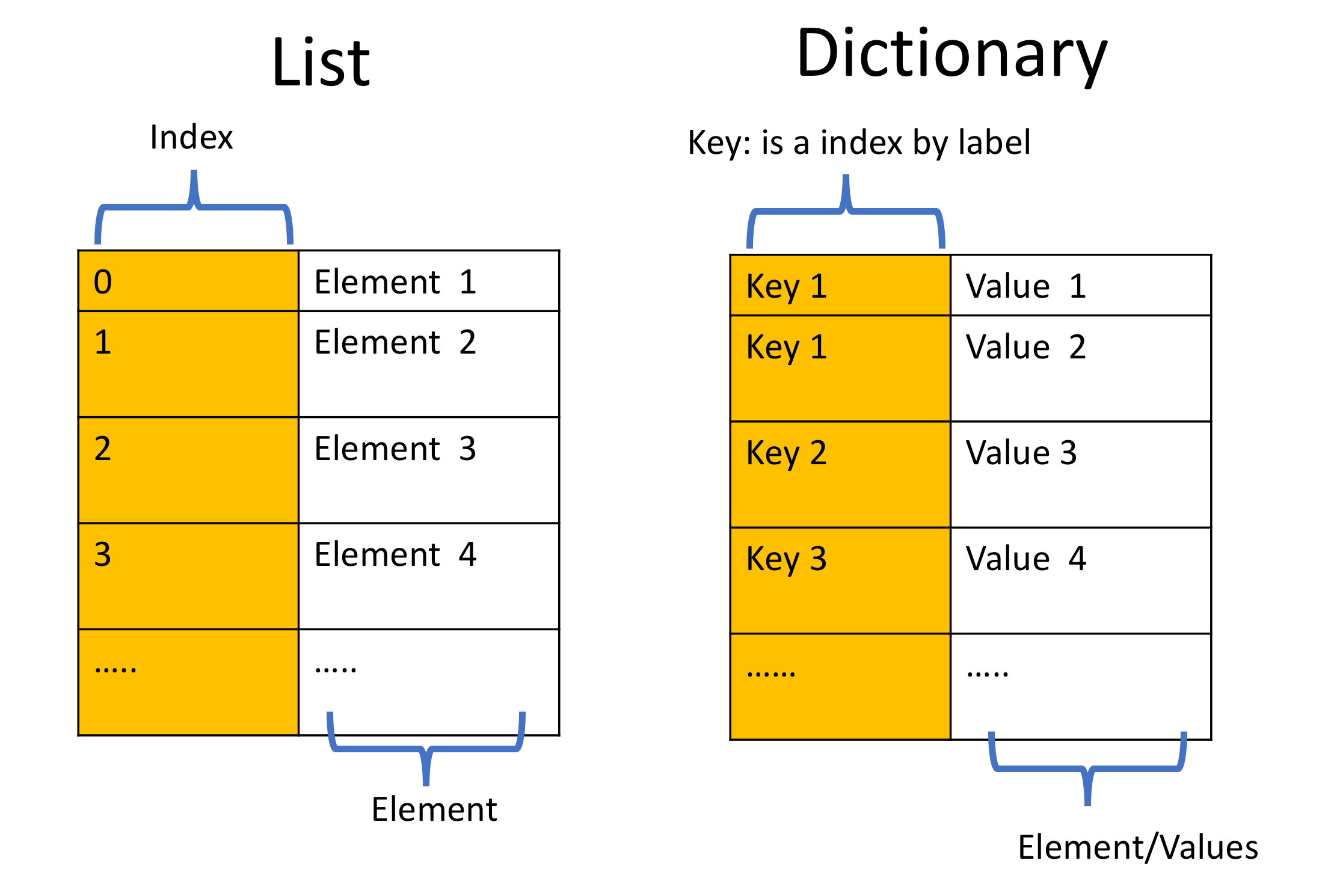🐍 Python Data Structure and Functions#
👨🏫 Vikesh K
📓 Lab 02
💡 Don’t learn and then start, start and then learn - Anon 💡
📝Lab Agenda#
Data Structures
List
Dictionary
Tuples
Loops
Functions
Exercises
Theory#
Data Structure Summary#

Properties#
Lists#
Lists are also ordered sequence
They can be modified
Lists can also contain multiple data types
Lists can be nested
List elements can be accesed via an index; also negative index
Index can also be used to slice the lists
You can contcatenate lists by combining them
l1 = [2 , 3]l2 = [5 , 6]l3 = l1 + l2
.extend()method can be used to add elements to the list

Tuples#
Tuples are ordered sequence
height = (5.11, 5.5, 5.8, 5.5)
Different type of variables can be contained in a tuple,
str,intetc.The elements can be accesed via an index, staring from 0
negative index can also be used
One can concatenate tuples by adding them
tuple1 = (2,3,4)tuple2 = tuple1 + (6,7)
Once created, you can’t manipulate a tuple. You will have to create a new tuple
Tuples can be nested. Tuples within tuples
nested_tuple = (1,2,("salt,"sugar"), (3,4))
Dictionary#
A dictionary consists of keys and values.
Compared to lists, instead of the numerical indexes, dictionaries have keys.
These keys are used to access values within a dictionary.

Key Functions#
Please type each of the code individually and see how it works
List Functions#
# Creating a sample list
my_list = [3, 4, 5, 6, 7, 8]
# Adding elements to the list
my_list.append(9) # Adds 9 to the end of the list
my_list.insert(0, 2) # Inserts 2 at index 0
my_list.extend([10, 11]) # Adds multiple elements to the end of the list
# Removing elements from the list
my_list.remove(3) # Removes the first occurrence of 3 from the list
my_list.pop() # Removes and returns the last element of the list
my_list.pop(2) # Removes and returns the element at index 2
# Accessing and modifying elements in the list
my_list[0] = 1 # Replaces the element at index 0 with 1
my_list[2:4] = [0, 0] # Replaces elements from index 2 to 4 with 0 and 0
# Sorting the list
my_list.sort() # Sorts the list in ascending order
my_list.sort(reverse=True) # Sorts the list in descending order
sorted_list = sorted(my_list) # Returns a new sorted list without modifying the original list
# Other useful methods
length = len(my_list) # Returns the number of elements in the list
count = my_list.count(5) # Returns the number of occurrences of 5 in the list
index = my_list.index(6) # Returns the index of the first occurrence of 6 in the list
Dictionary Functions#
# Creating a sample dictionary
my_dict = {"apple": 2, "banana": 3, "orange": 4}
# Accessing and modifying dictionary items
my_dict["apple"] = 5 # Modifies the value for the key "apple"
my_dict["pear"] = 6 # Adds a new key-value pair to the dictionary
del my_dict["orange"] # Removes the key-value pair with key "orange"
# Getting information about the dictionary
keys = my_dict.keys() # Returns a view object of the dictionary keys
values = my_dict.values() # Returns a view object of the dictionary values
items = my_dict.items() # Returns a view object of the dictionary (key, value) pairs
# Other useful methods
length = len(my_dict) # Returns the number of key-value pairs in the dictionary
exists = "pear" in my_dict # Returns True if the key "pear" exists in the dictionary
Tuple Functions#
# Creating a sample tuple
my_tuple = (1, 2, 3, 4, 5)
# Accessing tuple elements
element = my_tuple[0] # Returns the first element of the tuple
slice = my_tuple[1:3] # Returns a new tuple with elements from index 1 to 3 (exclusive)
# Getting information about the tuple
length = len(my_tuple) # Returns the number of elements in the tuple
count = my_tuple.count(3) # Returns the number of occurrences of 3 in the tuple
index = my_tuple.index(4) # Returns the index of the first occurrence of 4 in the tuple
Exercises#
List#
x = ["a", "b", "c"]
print(x)
['a', 'b', 'c']
# length - How many elements are in the list
# what is the type of x
# get the 3rd element of the list
Q Extract London from the sentence
x = "London is a big city"
# x[start:stop:step]
Q What will be the result of [1,2,3] + [1,1,1]
Hint: The mathematical operations on list are very similar to how they work on string
# your code here
Q What will be the result of x = [1,2,3] and x.extend([1,1,1])
# your code here
You will notice that the memory location of z remains the same in the below example. This highlights the property that list are mutable
Visualise the steps on here
Q What will be the result of x = [1,2,3] and x.append([1,1,1])
# your code here
Visualise the steps here
Q What will happen when we do z = [2,3,4]; z[0] = 5
# your code here
Q On doing the below steps?
q = [1,2,3]r = qr[0] = 9
What will be q[0]?
# your code here
Visualise the steps here
Q If S is a list what does the following syntax do: T = S[:]?
# your code here
Using the [:] creates a deep copy and then s and t are not referencing to the same memory block.
Visualzise the steps here
Q Consider the following list : A = ["john",11,1.4] . What will list A contain after the following command is run: del(A[0])?
# your code here
Q In the list L = [1,2,[3,'a'],[4,'b']]. How to extract 'b'?
# your code here
Q What is the result of the following operation: 'P,Q,R,S'.split(',')? What will be the type of the output?
# your code here
Tuples#
tuple1 = (2,3)
print(tuple1)
print(type(tuple1))
(2, 3)
<class 'tuple'>
tuple1[0]
2
Q What is the result of the following: len(("salt",10,1.2, "sugar",10))
# your code here
Q Consider the tuple tuple_a = ("P","Q","R"), what is the result of the following operation tuple_a[-1]?
# your code here
Q Consider the tuple A=((11,12),[21,22]), that contains a tuple and list. What is the result of the following operation A[1]
# your code here
Q Consider the tuple A=((11,12),[21,22]), that contains a tuple and list. What is the result of the following operation A[0][1]?
# your code here
Dictionary#
Its important that the key of the dictionary, is immutable. hence it can only be a number, a string or a tuple
# Create a sample dictionary
release_year_dict = { "Random_Album": ["1982","1984"],
"Back in Black": "1980", \
"The Dark Side of the Moon": "1973",
"The Bodyguard": "1992", \
"Bat Out of Hell": "1977",
"Their Greatest Hits (1971-1975)": "1976", \
"Saturday Night Fever": "1977", "Rumours": "1977"}
release_year_dict
{'Random_Album': ['1982', '1984'],
'Back in Black': '1980',
'The Dark Side of the Moon': '1973',
'The Bodyguard': '1992',
'Bat Out of Hell': '1977',
'Their Greatest Hits (1971-1975)': '1976',
'Saturday Night Fever': '1977',
'Rumours': '1977'}
# Get all the keys in dictionary
release_year_dict.keys()
dict_keys(['Random_Album', 'Back in Black', 'The Dark Side of the Moon', 'The Bodyguard', 'Bat Out of Hell', 'Their Greatest Hits (1971-1975)', 'Saturday Night Fever', 'Rumours'])
# Get all the values in dictionary
release_year_dict.values()
dict_values([['1982', '1984'], '1980', '1973', '1992', '1977', '1976', '1977', '1977'])
release_year_dict['Back in Black']
'1980'
Add enteries to the dictionary
# Append value with key into dictionary. Add 2007 to Graduation
Delete enteries
# Delete Thriller enteries
for Loops#
for loop is a powerful tool that lets us look at every item in a data structure in order and perform operations on each element.
my_list = ['x', 'y', 'z']
for item in my_list:
print(item)
x
y
z
The for loop executes print three times, once for each item in the list. It works for tuple as well
my_tuple = ('x', 'y', 'z')
for t in my_tuple:
print(t)
x
y
z
for loop can also be used for the letters in a string
for c in "Hello CDS":
print(c)
H
e
l
l
o
C
D
S
range is a function that returns a sequence of numbers. It can take one argument, two arguments, or three arguments.
When you give one argument to range, it is considered to be the end of the range (exclusive).
for i in range(6):
print(i)
0
1
2
3
4
5
When you give three arguments to range, they are considered to be the start (inclusive), end (exclusive), and step size of the sequence.
for i in range(30, 150, 30):
print(i)
30
60
90
120
Functions#
Functions are a way to organize and re-use your code. Functions allow you to take a block of your code, give it a name, and then call that code by name as many times as you need to.
Functions are defined in Python using the def statement.
def my_function():
print("A plain function")
my_function()
A plain function
def sum_of_squares(x, y):
z = x**2 + y**2
return z
sum_of_squares(3,4)
25
Make a Cube function
def cube(n):
pass # your code goes here
print(cube(5))
None
📚 Resources#
Python Tutor - A very good website to visualise the steps in Python. This is helpful to develop intuition behind the steps
Data Structure in Python
